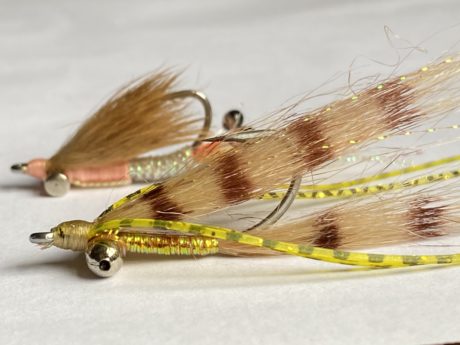Today’s post comes from Rapid’s Camp Lodge Guide and Andros South Lodge Bonefish School Instructor, Jeremy Inman. Jeremy’s extensive experience as a Saltwater Guide in Hawai’i and overall fishy instincts brings us some tips on filling your fly box with the right flies for bonefish on Andros. Enjoy!

It’s no secret that the Gotcha fly pattern is the bread and butter when fishing for bonefish at Andros South, as well as a guide’s top pick for a day of fishing. The bonefish on Andros are plentiful and don’t receive very much pressure, so having the Gotcha fly pattern in varying sizes and weights for different situations (see past blog posts on that subject) will cover a majority of your needs whether you’re wading on foot or fishing from the bow of a boat. Regardless if you plan on tying or buying your flies, understanding a few important, often overlooked features to a pattern’s components and construction can really help you assemble the perfect fly box and increase your success on the flats on Andros.
Three things to consider when choosing a fly:
- hook size
- type amount of weight used to sink a fly (bead chain, nickel, brass, or lead)
- type of material the fly is composed of
Simply put, the larger the hook that the fly is tied on, the more weight it will need to keep it riding hook point up in the water. The more heavily the fly is weighted, the louder its entry into the water. The more buoyant the material is you use to tie a fly, the slower it will sink. Materials such as rabbit and craft fur have very little buoyancy, therefore will sink much faster than flies tied with a highly buoyant material like bucktail, calf tail, or deer hair.
One of the best sights while flats fishing is seeing bonefish going ultra-shallow, tailing, and happily feeding between the mangroves and in the weed beds. My fly choice for this? A very lightly weighted fly tied on a somewhat smaller hook (size 4-6) with a highly buoyant wing. The shallower the water, the closer the fly must land to the fish’s nose (think dinner plate) since they won’t be able to see as far as they could if they were in deeper water. The buoyant wing will help your fly sink slower and roll hook point up as soon as it hits the water. In turn, allowing more time for the fish to see your fly as it sinks, as well as keeping your fly from snagging bottom or picking up globs of weeds on your hook.
While I’ve caught plenty of bonefish using a weed guard, personally I believe that the better a guard is at keeping your hook from grabbing anything unwanted, the better it will be at preventing the hook from sticking into a fish’s lip.
Standing on the bow of a boat, fishing deeper flats, or sloping beach drop-offs near the channel will often give you shots at very large fish. While you’ll need a heavier weighted fly in 2-4 feet of water, the heavier the fly is, the louder its entry into the water will be. Therefore I choose to tie my deeper water patterns sparsely and on larger hooks (size 2) with materials like craft fur that allow my fly to sink much faster. The extra depth gives your fly much more time to turn over underwater, relying on your weight to sink it with the hook point up. With the increased sink rate you can use a little less weight and still get your fly to the needed depth, reducing the amount of noise the fly makes as it hits the surface and spooking fewer fish.
Examples of flies with little buoyancy:
- Peterson’s spawning shrimp (rabbit)
- Veverka’s mantis shrimp (craft fur)
Example of flies with buoyant wings:
- Crazy Charlie (calf tail)
- Bonefish Horror (bucktail)
Other Andros Fly Posts:
Leave a Reply